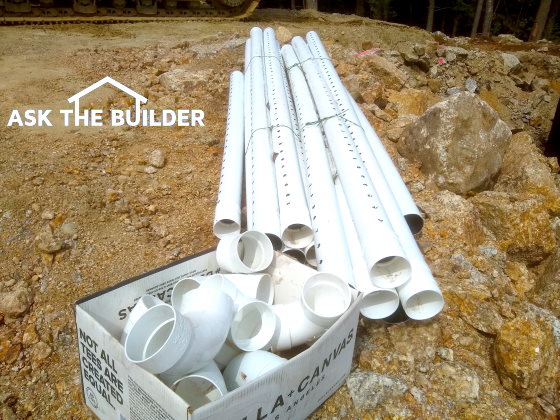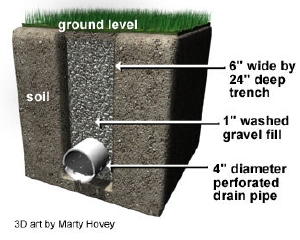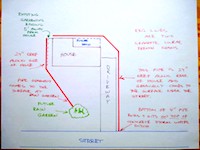Groundwater Flow Direction

Groundwater Flow Direction | This is perforated drainage pipe that collects groundwater and redirects it to another spot in your yard. The box is full of handy fittings to turn corners. Copyright 2021 Tim Carter
Groundwater Flow Direction - It's Almost Always Sideways and Down
Your home may be plagued with a wet basement or crawlspace where water enters at will when it rains outside. In addition, your yard may be the neighborhood bog rendering it useless in the wet season. Would you be interested in knowing how to make your basement, crawlspace, and possibly your yard as dry at the Atacama Desert? I thought so.
I was quite fortunate to major in geology in college. One of the classes I took was hydrogeology which focuses on groundwater. The knowledge I obtained allowed me to build homes in dense clay soil that had bone-dry basements. Just about every other homeowner in Cincinnati suffered from wet basements, but not my customers.
Not a week goes by that I don’t do a specialized consult for a homeowner like you that suffers from water issues. Just a few days ago, I solved a chronic drainage problem a woman had spent over ten thousand dollars to fix to no avail. She was stunned to discover she would have a dry yard and crawlspace for less than $500 and a few weekends of moderate labor.
Do you want me to SOLVE your wet basement or crawlspace issue? CLICK or TAP my nose or CLICK HERE and let's get to work. I've helped thousands of homeowners like you who suffer from water leaks, mold, mildew, and soggy yards.
The homeowner was thrilled to see the customized drawing I made for her showing her exactly how to capture the subsurface water that was causing the issue. Here's a small example of one that I've made recently. Each drawing is unique custom-made for each situation. CLICK or TAP HERE now to order your drawing.
It gave me great pleasure as well to ratchet back her stress. She was a mess each time rain was in the weather forecast. Thanks, Dr. Pryor for teaching me what’s going on with groundwater so I can continue to help others!
How Does Groundwater Flow?
It’s important to realize that to understand groundwater and how it moves, you need to get a handle on the soil around your home. Not all soils are the same. Many years ago the government spent millions of dollars creating soil maps that you can access for free online. Just do a search similar to this: Cincinnati OH soil maps
Some soils are very well-drained like the one around my house here in central New Hampshire. The typical soils here are thin and very sandy, a result of the erosion of the granite bedrock. However, the soil in my hometown of Cincinnati is the exact opposite. There’s thin topsoil and under it are feet of dense clay you can use to make pottery. Water doesn’t travel down through the clay at all. This is why it’s easy to build a pond in southwest Ohio.
Does Water Flow Through Topsoil?
Topsoil almost always has lots of air in it. Insects help create these void spaces. When it rains, water soaks into the topsoil displacing the air. When the topsoil can absorb no more water, it starts to flow overland. Some weather warnings talk about flood risk when the ground or soil is saturated from snowmelt or heavy rains in previous days. Now you know why it’s happening.
Gravity takes over after the rain gets in the soil. This amazing force of nature starts to pull the water down but another law of physics comes into play. The water wants to take the path of least resistance on its journey back to the ocean. This means that the water in the soil usually starts to travel sideways through the topsoils. In most soils, the resistance to movement increases with depth.
What Causes Water to Flow Sideways?
A dense clay subsoil, as well as bedrock close to the surface, can aid in this sideways movement. Realize that some of the water moving through the soil finds cracks in the bedrock and flows down to fill them. This is what keeps drilled wells wet as the water fills up miles of tiny and large cracks that are like 3D spiderwebs in the bedrock under your feet.
To stop water from entering your basement or crawlspace, you need to capture the water moving sideways through the soil. Remember, water likes to take the path of least resistance so create one for it to bypass your basement, your crawlspace, or your yard!

Cross-section of a Linear French Drain including the all-important perforated french drain pipe. Copyright 2017 Tim Carter ALL RIGHTS RESERVED - Do NOT COPY this graphic.
How Wide Should the Trench Be?
I’ve had fantastic success for over forty years digging a 6-inch-wide trench down about 24 inches. I put in 2 inches of washed rounded gravel in the bottom of the trench. The gravel is about the size of green grapes, maybe as large as walnuts. It can be angular, but be sure there are no smaller stones or sand in the gravel. You want lots of air spacing in this gravel because the water will much rather flow down through this gravel and into a buried drainpipe than try to push its way through the topsoil.
What Type of Drain Pipe is Best?
I then put a 4-inch perforated drain pipe on top of the 2 inches of gravel. I prefer to use the solid white ABS or PVC plastic pipe that has rows of holes drilled in it. I’ve never been a fan of the black corrugated drain pipe with the narrow slits in it. Always install the pipe so the rows of holes point down. If you don’t, the water in the trench needs to raise all the way up to where the holes are to get into the pipe. What’s more, if the holes point up, gravel that you put on top of the holes can block the holes. That’s bad jujumagumbo.
Should the Pipe or Trench Have Fall and How Much?
The bottom of the trench can be parallel with the top surface of the ground around your home. At the very least the pipe in the trench needs to be level or have 1/8 per inch of fall to it. Even if the pipe is level, water will readily flow through it. Think about how lakes don’t overflow. Once the pipe is installed, fill the trench to within 1 inch of the surface with the rounded or angular gravel.
Where Does the Collected Water Go?
The pipe needs to extend to a low spot on your land. As the ground falls away from your house to the low spot, the pipe will naturally pop to the surface if you install the pipe level or have a minimal amount of fall to it. The pipe needs to break through to the surface so it can disgorge the water it’s collected sending it on its way to the ocean.
Should the Drain Pipe Have a Filter-Fabric Sock?
No. Do NOT install a filter-fabric sock on the drain pipe. Be sure you don’t line the trench with a filter fabric. Those materials are designed to keep gravel under parking lots and roadways from being fouled with mud. Water flowing through topsoil has already been filtered of this silt so the fabrics are unnecessary.
The proof that you don't need a filter fabric is right in front of you. Look at the water flowing from any natural spring. It's crystal-clear. The topsoil acts as a natural filter, silly!
This column was introduced in the August 15, 2021 AsktheBuilder Newsletter.
Column 1418



One Response to Groundwater Flow Direction